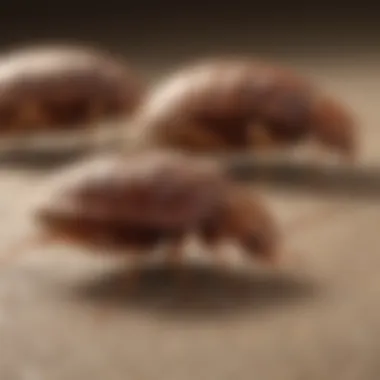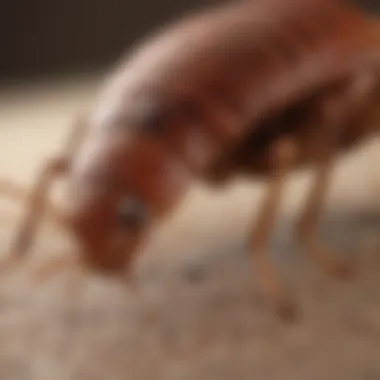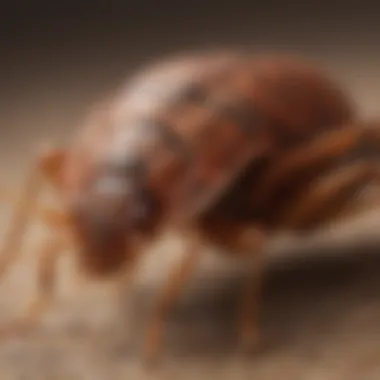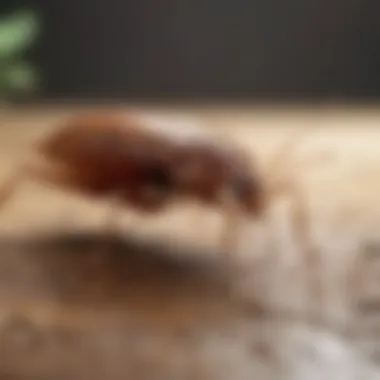Identifying Bugs That Resemble Bed Bugs


Intro
When considering pest management, identifying the right insects plays a critical role. This article focuses on various insects that share similarities with bed bugs. Knowledge of these impostors can prevent unnecessary panic and guide effective management strategies.
Understanding and differentiating these insects empowers homeowners and enthusiasts to act confidently against pest issues.
Animal Overview
Common Names
Numerous insects exhibit physical traits akin to bed bugs. Some common names include:
- Bat bugs
- Bird mites
- Fleas
- Cloak bugs
These insects vary significantly in behavior and ecological roles, yet their resemblance can lead to confusion during identification.
Scientific Classification
The look-alikes of bed bugs belong to different families within Hemiptera. For example:
- Bat bugs are classified as Cimex pipistrelli.
- Fleas belong to the order Siphonaptera.
This classification highlights the diversity of insects similar in appearance but significantly different in habits.
Geographic Range
Insects resembling bed bugs can be found globally, with specific distributions depending on their ecological niches. For instance:
- Bat bugs are prevalent where bats inhabit.
- Bird mites are primarily near avian nests.
This geographic variability emphasizes the need for keen observation and understanding of local pest species to ensure accurate identification.
Behavior and Social Structure
Social Behavior
Interactions among these insects are crucial for understanding their behaviors. Many, such as fleas, tend to be solitary, relying on their hosts for survival. Conversely, bat bugs may be found in groups near roosting sites.
Communication
Due to their size and lifestyle, these insects have limited communication methods. Fleas use physical movements to interact, while bat bugs may rely on pheromones for mating signals.
Mating and Reproduction
Reproductive strategies differ widely. Bed bugs engage in traumatic insemination, while some simile insects may lay eggs in clusters or rely on hosts for nurturing their young. This understanding is vital for proper pest management, targeting high reproductive species efficiently.
Habitat and Ecosystem
Natural Habitat
Each insect has adapted to unique habitats. Bat bugs, for example, are most commonly found in areas where bats roost, while bird mites are often located in nesting zones around birds. Understanding these habitats aids in scouting for potential infestations.


Food Sources and Diet
Dietary habits are diverse. Dependent on the insect:
- Bat bugs feed on the blood of bats.
- Bird mites feed on birds and sometimes humans.
- Fleas prefer feeding on mammals, particularly cats and dogs.
This variety in diet demonstrates the differing ecological roles that these look-alikes play, thus informing management practices.
Role in Ecosystem
Insects that resemble bed bugs are significant in their respective ecosystems. While some serve as pests, others are essential for food webs. This balance often influences pest control strategies and the need for careful management to protect beneficial insects while addressing potential pests.
“Identifying insects accurately is crucial not just for pest control, but for maintaining ecological balance.”
By comprehensively understanding insects that resemble bed bugs, one can approach pest management with a clear vision and effective strategies. The knowledge gained here aids in distinguishing these pests, forming the foundation for more fruitful pest identification and management endeavors.
Foreword to Bed Bugs
Understanding bed bugs is crucial for anyone involved in pest management or interested in entomology. This section offers foundational knowledge necessary to identify and distinguish bed bugs from other insects that share similar characteristics. With an awareness of what bed bugs are, their biology, and behavioral patterns, readers can better assess their pest situations and communicate effectively regarding infestations.
Defining Bed Bugs
Bed bugs, scientifically identified as Cimex lectularius, are small, wingless insects that primarily feed on the blood of humans and other warm-blooded animals. Adult bed bugs are typically around 4 to 5 millimeters in length. They are flat, oval-shaped, and reddish-brown, allowing them to hide in various crevices and seams of furniture and along warm resting places. Understanding their physiognomy—flattened body, recognizable coloration—is essential to effective identification. Knowledge about their life cycle, from egg to adult, highlights how quickly these pests can proliferate, leading to serious infestations.
The Rise of Bed Bug Infestations
In the past two decades, bed bug infestations have been on the rise across urban and rural settings alike. Factors contributing to this resurgence include increased international travel, the importation of used furniture, and resistance to common pesticides. Bed bugs are notorious for their ability to reproduce rapidly, making early detection and intervention more critical than ever.
Data suggests that in 2021, approximately 8% of US households reported an infestation of bed bugs. This staggering statistic underscores the significance of understanding bed bugs not only for pest control specialists but also for homeowners and educators. Knowledge serves as the first line of defense against bed bug infestations. By being informed, individuals can take proactive measures to prevent and manage potential outbreaks.
Physical Characteristics of Bed Bugs
Understanding the physical characteristics of bed bugs is essential in differentiating them from insects that resemble them. Such knowledge assists in effective pest identification and management strategies. By examining specific attributes like size, shape, color, and texture, individuals can improve their detection skills. This section will provide nuanced insights into these traits, making it easier for pest control enthusiasts, veterinarians, and educators to spot, assess, and respond to household pest issues.
Size and Shape
Bed bugs are generally small, flat, and oval-shaped insects, measuring approximately 4 to 5 millimeters in length. Their bodies resemble a lentil but can expand when they feed. This flatness allows them to hide easily in small crevices, such as between mattress seams or behind picture frames.
It's vital to note that the size and body shape can vary slightly depending on their growth stage. The nymphs, or immature bed bugs, are smaller and lighter in color than fully developed adult ones. They can be as small as 1 millimeter when they first hatch, making them less noticeable but still contributing to the overall pest problem.
The shape of bed bugs contributes to their ability to hide effectively. They can flatten their bodies to escape into tight spots. This physical characteristic is significant as it dictates how and where infestations often occur.
Coloration and Texture
Bed bugs exhibit a range of colors, which change depending on their feeding cycle. They are generally reddish-brown when well-fed, but can appear paler or even yellowish after molting. The smooth, shiny texture of their bodies can make them look slightly glossy, especially after a blood meal.
Their coloration and shine can confuse them with other insect species like the carpet beetle or some types of pests found in bird nests. Thus, understanding subtle differences in color can enhance identification accuracy.
In summary, size and shape, alongside coloration and texture, are crucial in distinguishing bed bugs from look-alikes. By recognizing their physical traits, one can detect infestations more effectively and take appropriate action. As professionals and enthusiasts become more adept at identifying these characteristics, they improve their overall pest management strategies."
Common Bugs That Look Like Bed Bugs


Identifying insects that resemble bed bugs is crucial for effective pest management. Bed bugs are notorious for their infestations in homes and public spaces. However, there are several look-alike species that can lead to confusion. Understanding these bugs helps in distinguishing between actual bed bug infestations and the presence of benign insects. This knowledge empowers homeowners and pest control professionals to make informed decisions. It also prevents unnecessary panic and expense during pest identification efforts.
Bat Bugs
Bat bugs are closely related to bed bugs and often mistaken for them. They are roughly the same size, about 4 to 5 mm long, and have a similar oval shape. The primary distinguishing feature is their hair. Bat bugs have longer hairs, giving them a fuzzier appearance than the smoother bed bugs. They also feed on the blood of bats, and human encounters usually occur when bats roost in the vicinity.
Being aware of this bug's habits can help mitigate concerns. If bat bugs are prevalent, it signifies a need to address the larger problem of a bat colony nearby rather than focusing solely on bed bug treatment.
Bird Bugs
Bird bugs, particularly the Cimex lectularius, bear a striking resemblance to bed bugs. They are slightly smaller, approximately 4 mm in length. Unlike bed bugs, bird bugs generally feed on birds and will bite humans when their food sources are limited. Identifying their presence suggests that there might be bird nests nearby.
Much like bat bugs, controlling the source is key here. A nest removal strategy may be necessary alongside insect control to prevent future infestations.
Carpet Beetles
Carpet beetles are often mistaken for bed bugs due to their oval shape and similar size. However, they have a more varied color pattern, including blacks, browns, and even yellows. Unlike bed bugs, which are blood feeders, carpet beetles primarily feed on organic materials, including fabrics and stored food products.
Recognizing that carpet beetles are typically harmless can be comforting. Beyond the inconvenience of damaging fabrics, they do not pose health risks to humans. This differentiation is essential for effective pest management, as it informs treatment strategies needed to eliminate carpet beetles without targeting bed bugs unnecessarily.
Fleas
Fleas are another common bug that can confuse the untrained eye. While they are noticeably smaller, about 1 to 4 mm in size, their jumping ability can create the illusion of being more widespread. Fleas are dark brown, and unlike bed bugs, they possess a more flattened body structure, adapted for jumping.
The bite of a flea leads to irritation and itching, distinguishing it from the more discrete bites of bed bugs. If a person has pets, it is more likely that fleas are the issue. Recognizing flea issues allows for targeted treatments focusing on yard and pet hygiene, reducing the need for blanket bed bug treatment.
Other Related Species
Various other species may resemble bed bugs. For example, the Cimex acronymatus or the Cimex hemipterus can also lead to misidentifications. They share similar habitats and feeding behaviors. Specific behavioral traits, including nocturnal activity and feeding patterns, offer crucial clues. These insects are mostly found in warm and humid areas, making it essential to keep such areas inspected regularly.
Distinguishing Features Among Look-alike Bugs
Color Differences
Color plays a significant role in identifying bed bugs and their look-alikes. Bed bugs typically have a reddish-brown hue, which varies with their life stage and diet. For instance, newly fed adults and nymphs can appear more translucent and lighter. In contrast, other bugs might have different colors altogether.
- Bat bugs are somewhat similar in size but often appear greyer due to their thicker fur covering.
- Bird bugs, on the other hand, tend to be more yellowish or even lighter brown.
- Carpet beetles can be mistaken for bed bugs at first glance, but their coloration is often more varied, featuring iridescent patterns.
By paying attention to these subtle differences in color, one can significantly narrow down possibilities when faced with an insect resembling a bed bug.
Body Shape Variations
The body shape is another key indicator. Bed bugs display a flattened oval shape that assists with their hiding in small crevices. Understanding how body shapes differ can help in correct identification.
- Bat bugs have bodies that are similar in size but somewhat more elongated and fuzzy.
- Fleas are distinctly rounded, also very tiny.
- Carpet beetles have a more rounded and robust body, which deviates from the typical shape of bed bugs.
Each of these insects carries unique identifiers in their shape. By analyzing the minor differences in form, more accurate identifications can be made.
Behavioral Discrepancies
Besides physical traits, monitoring the behaviors of suspected insects can provide further clues. Bed bugs predominantly are nocturnal, feeding primarily during the night. They show a characteristic retreat to hidden areas throughout the day. Understanding their behaviors informs one about their presence and helps differentiate look-alikes.


- Fleas display much more active jumping, especially when provoked, a behavior unique to their lifestyle.
- Bird bugs may be found near bird nests or droppings, exhibiting a tendency to stay close to their hosts.
- Carpet beetles, often seen crawling on surfaces, will not have the same hiding behavior as bed bugs.
Observing these behaviors provides an essential layer to the identification process.
Accurate identification of bed bug look-alikes can save time and resources in pest management efforts, creating a more effective approach to treatment.
The Role of Bed Bugs in Ecosystems
Understanding the role of bed bugs in ecosystems is crucial to grasp their ecological significance despite their notoriety in human habitats. While bed bugs are often considered pests due to their impact on people, analyzing their interactions within ecosystems reveals a more complex picture.
Impact on Human Habitats
Bed bugs primarily thrive in human dwellings, relying on human blood for sustenance. Their presence can lead to discomfort and a significant psychological burden on inhabitants. While they do not transmit diseases, their bites can cause itching and allergic reactions.
The repercussions of a bed bug infestation extend beyond mere irritation. They can affect the quality of life, causing anxiety and stress. Moreover, their effective management requires resources, impacting economic aspects for homeowners and renters alike.
In urban settings, bed bugs can also influence human behavior. People may avoid shared spaces such as libraries or public transportation for fear of encountering these pests.
Ecological Contributions
Despite their negative reputation, bed bugs play a role in the ecosystem that is often overlooked. They are part of the food web, serving as prey for various predators, including some species of spiders and beetles.
Bed bugs contribute to nutrient cycling as their decomposition adds organic material to the environment. Furthermore, their presence helps maintain the balance of ecosystems at a microscopic level. Research is still ongoing to better understand these roles, as much of their ecological contributions remain underexplored.
"Every insect, including bed bugs, participates in a complex relationship within ecosystems that extends beyond human health concerns."
In summary, the role of bed bugs in ecosystems, while often overshadowed by their nuisance to humans, is significant. Their impacts on human habitats and ecological contributions are both vital areas of study for understanding pest dynamics and developing integrated pest management strategies. This perspective allows for a more comprehensive approach to pest control, underscoring the importance of considering ecological interactions in managing bed bug populations.
Pest Control and Management
Pest control and management are critical components in addressing the issues related to bugs resembling bed bugs. Such bugs can cause confusion among homeowners and pest control professionals alike. Understanding the nature of these insects helps us implement effective strategies to prevent infestations. Effective pest management combines various approaches, emphasizing the importance of knowledgeable identification and prompt action in safeguarding living spaces.
Preventive Measures for Bed Bugs
Preventing bed bug infestations requires a strategic combination of vigilance and proactive measures.
- Regular Inspection: Conduct systematic checks of mattresses, box springs, and headboards. Early detection is crucial to managing possible infestations.
- Encasements: Utilizing protective encasements for mattresses and pillows can limit the hiding spots for bed bugs, making it harder for them to thrive.
- Decluttering: Reducing clutter in living areas denies bed bugs potential harborage sites. Keeping household items organized aids in easier inspections as well.
- Travel Precautions: When traveling, inspect hotel rooms and keep luggage off the floor. Always wash items upon returning home to reduce the risk of bringing bugs back.
- Heat Treatment: Utilizing heat as a method for killing bed bugs is effective. Washing bedding in hot water and using high-temperature drying can be beneficial.
Implementing these measures can significantly lower the likelihood of infestation. However, persistent vigilance remains essential in ensuring that these preventive strategies are working effectively.
When to Call a Professional
At times, pest control measures may be insufficient, and the expertise of a professional may become necessary. Here are some points to consider when deciding to seek professional help:
- Signs of Infestation: If you notice consistent signs of bed bugs or their look-alikes despite preventive efforts, it may indicate a more significant problem.
- Widespread Presence: If bugs are found in multiple locations or rooms, a professional pest control service can address the issue comprehensively.
- Unsuccessful DIY Methods: Should your attempts to eliminate the pests prove unsuccessful, external help can provide more efficient solutions.
- Health Concerns: If infections or allergies are a problem due to bug bites, professional intervention is advisable to mitigate health risks.
- Expert Assessment: Professionals possess the skills to identify and differentiate between bed bugs and similar insects. This identification is vital in applying correct treatment methods.
In many cases, early intervention by pest control professionals can substantially reduce the cost and impact of a potential infestation.
Epilogue
Understanding the various insects that resemble bed bugs is crucial for homeowners and pest management professionals alike. This article emphasizes the significance of accurately identifying these bugs to prevent unnecessary panic and misinformed pest control measures. By recognizing the unique features and behaviors of these look-alikes, individuals can make informed decisions regarding pest management strategies, thus ensuring better outcomes.
Summary of Key Points
- Bed bugs are commonly confused with other insects, leading to misidentification.
- Key characteristics help differentiate these bugs, such as color, shape, and behavior.
- Understanding the role of these insects in the ecosystem provides context for their presence.
- Effective pest management can be achieved through knowledge and preventive measures.
Final Thoughts on Pest Identification
Accurate pest identification forms the backbone of any effective pest control plan. The knowledge shared in this article empowers readers with the tools needed to discern between bed bugs and their look-alikes. Staying educated about potential pest issues can greatly reduce the stress associated with infestations. When uncertainty occurs, consulting a professional can further enhance the understanding and resolution of pest-related concerns. In essence, being well-informed can lead to a more efficient approach in dealing with pests.







